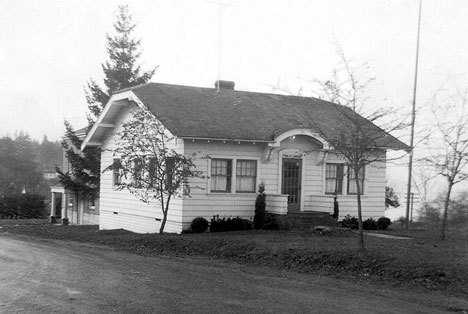The original section of the Langley Library has been added to the Langley Historic Preservation Commission’s Register of Historic Places.
The front portion of the library at Second Street and Camano Avenue, which dates back to a brainstorming session by the Ladies’ Civic Improvement Club in 1916, is the fifth historic property in the city to be added to the list.
It joins Langley City Hall, South Whidbey Historical Museum, the old section of Langley Woodmen Cemetery and the Wylie hospital-birthing house on Edgecliff Drive.
“We’re trying to preserve the look and feel of Langley,” said Bob Waterman, a Langley city councilman and the chairman of the Historic Preservation Commission.
He said the two-fold mission of the group is to work for the preservation of historic buildings and sites, and to educate the community about Langley’s past.
Helen B. Coe, who was elected Langley’s first mayor in 1919, was a force behind the library project. She donated the land and $500 to a building fund, an amount equal to three-fourths of the town’s annual budget at the time.
Meanwhile, books began to be collected. They were kept at the original Star Store down the block until the library was completed in 1922.
The building was dedicated in January 1923 to “the young men of Langley and vicinity who served in the World War,” according to a plaque on the east facade.
The new building served as both a library and a recreation hall. Heat came from a fireplace burning donated wood stored under the wall seats, until electricity was installed in 1924.
Coe and Lila McRae were early librarians.
Meanwhile, a number of local groups took to meeting at the hall, including the Co-op Egg Association, the Republican and Democratic Clubs and the telephone company.
Langley’s town council conducted meetings there in 1929, paying $3 per month for the privilege. Episcopal and Christian Science churches also held services in the building.
The Civic Club deeded the land and building to the city in 1943, and the city began to contribute to the library fund.
Sno-Isle Libraries, a regional system, was hired by the city to manage the library in 1961.
The center section, including the current entry stairway, was built in 1980, and the large west section of the library was completed in 1994.
Friends of the Langley Library secured a grant for about $177,000, and in addition contributed more than $200,000 toward the 1994 remodel. The city provided the rest of the money for the expansion, which more than doubled the size of the original building.
Today, head librarian Vicky Welfare and a staff of nine circulate an average of 11,000 volumes per month and serve more than 5,900 Langley-registered patrons.
Langley Library continues to be a community hub where children gather for story hour, teens use computers and adults participate in book-discussion groups.
Library resources include dozens of online informational databases and various media formats, as well as the latest best-sellers.
The next most recent addition to the historical list, the Wylie hospital-birthing house at 321 Edgecliff Drive, has an equally colorful history.
The two-story building was completed in 1913 by Francis Wylie and his family. When the Wylies divorced, Lillian Wylie remained in the house with the couple’s three children.
To make ends meet, she turned the house into a nursing home and birthing center. She had no formal nursing degree, but she read extensively about the subject.
She assisted visiting and local doctors with births, and several current citizens of Langley were born there. She also took in elderly and terminally ill patients, and cared for accident victims.
Lillian Wylie was elected to the all-women Langley Town Council in 1919. Her barn “was used to house cows that were removed from Langley’s streets and held until bailed out by their owners,” according to the nomination form to have the house included on the historic registry.
Waterman said the historic preservation commission, established about two years ago, is negotiating with a number of home and business owners, but so far there have been no additional nominees.
Meanwhile, the city is surveying about 60 other potential properties with the aid of $15,000 in grants, Waterman said.
Listings on the register are voluntary. Owners of pre-1958 properties are encouraged to apply for register listing, which may include tax credits for rehabilitation, he said.
Nomination forms are available at city hall, next to the now officially historic library.
“We welcome anyone who feels they have a historic building,” Waterman said. “We’re looking at historic homes, commercial buildings and other sites.”
For more information, call Waterman at 221-8644 or e-mail bobanne@whidbey.com.



